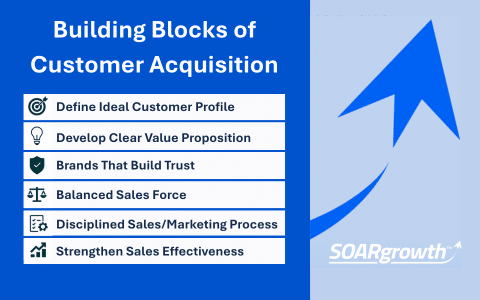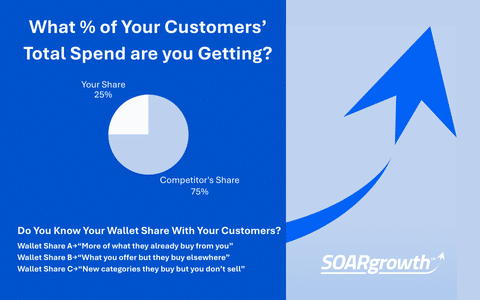By Larry Goddard, Laurence Franklin and Jennifer Goddard
Most businesses attribute growth to smart decisions—and often that’s true. But in many cases, the numbers are being lifted by market momentum more than intentional strategy.
This is the concept of Base Evolution—the natural trajectory your business will follow if you implement no new strategic initiatives. It’s what happens when external factors, rather than deliberate choices, shape your revenue, margins, and customer base. (Contrast this to our previous article about “Base Business Loss”, which is primarily impacted by internal factors).
Sometimes, Base Evolution creates the illusion of success. Other times, it quietly erodes your position while leadership is focused elsewhere. Either way, if you’re not accounting for it, you’re not fully in control of your growth.
This article explores what Base Evolution is, how it can distort your view of business performance, and what you can do to ride the wave more effectively—or change its direction entirely.
What Is Base Evolution?
Base Evolution is the organic change that occurs in your business because of external market forces—without any intentional new strategies, product development, sales push, or internal transformation. It’s the “do nothing” scenario.
In other words, if you change nothing—no new initiatives, campaigns, product lines, talent upgrades, or pricing strategies—your business will still evolve. But it will evolve in response to forces outside your control.
This evolution can lead to short-term growth, long-term stagnation, or even decline. It can be misleading, especially if you’re tracking top-line numbers without understanding the forces behind them.
External Factors That Shape Base Evolution
There are several major forces that most commonly drive Base Evolution:
A. Market Demand – The Rise and Fall of the Tide
Your business often grows or shrinks based on the direction of the market—independent of your effort. When the market is hot, even weak strategies can yield strong results. When demand cools, even solid businesses can struggle.
This is the classic “rising tide lifts all boats” scenario. But in business, not all boats are the same size—or equally seaworthy. Riding the wave of demand can work, but only if you’re positioned properly.
Example:
During the COVID-19 pandemic, demand for home improvement products skyrocketed. Hardware stores and suppliers saw record-breaking sales—without changing their strategies. They were simply in the right place at the right time. But when demand normalized, many struggled to sustain that growth.
The lesson? Market momentum may lift your business, but if you’re not preparing for the wave to recede, you’re vulnerable.
B. Price Increases – Inflation-Fueled Illusions
In an inflationary environment, raising prices often masks what’s really happening. Revenue climbs, margins may look healthier, and the financials might seem strong—yet the apparent growth is often just inflation at work, not real performance.
But price-driven growth isn’t the same as value-driven growth. If price increases aren’t supported by improved performance or customer satisfaction, they become fragile. Customers may tolerate higher prices in the short term—but they’ll remember when better options emerge.
Example:
In the early 2010s, global oil prices spiked to over $100 per barrel. Airlines responded with widespread fare hikes and added fuel surcharges. Revenues soared, and the industry appeared healthier than ever.
But much of that “growth” was driven by commodity inflation—not better customer experience or strategic execution. When oil prices later dropped, competition returned, margins tightened, and many airlines struggled to maintain profitability. Customers, burned by high surcharges during peak years, became more price-sensitive and less loyal.
The takeaway: growth inflated by pricing power alone is deceptive and vulnerable. If it’s not earned through improved value, it rarely lasts.
C. Trend Changes – Growth’s Best Friend or Its Silent Assassin
Shifting societal, technological, or industry trends can accelerate—or quietly sabotage—Base Evolution. When your offerings align with rising trends, growth often comes easily, even without new initiatives. But when trends shift away from your core, the same business can slip into decline while leadership is still reading last year’s playbook.
A company aligned with an emerging trend—like aging baby boomers, automation, health-conscious living, or remote work—can benefit from surging demand without changing its strategy. Growth appears strong, loyalty builds, and margins improve, all riding on the power of external movement. But the reverse is just as true. When trends turn, businesses that don’t adapt quickly get left behind. The decline may be masked at first—by loyal customers or legacy contracts—but eventually, the wave pulls back. By the time lagging indicators show trouble, it’s often too late to catch up.
Example:
Traditional cable TV providers enjoyed decades of stable Base Evolution. Subscriptions and ad revenue flowed steadily. But as the streaming trend gained momentum, customers began cutting the cord. Many cable providers initially downplayed the shift, attributing early losses to short-term changes. But the trend didn’t reverse—and by the time they responded, platforms like Netflix and Hulu had reshaped the landscape.
D. High-Growth Customers – Anchors or Engines?
Some businesses grow simply because their customers are growing. If you’re a supplier to a high-growth company or sector, your numbers may rise even if you do nothing differently.
This type of Base Evolution can be highly deceptive. You may feel like you’re executing brilliantly—when in fact, you’re just a passenger on someone else’s rocket.
Example:
NVIDIA has experienced explosive growth due to the rise of AI and data center demand. Suppliers to NVIDIA have naturally seen a huge surge in orders and revenues. In contrast, Intel’s slower performance has meant fewer opportunities for its supply chain partners. Companies aligned with NVIDIA are benefiting—but not because they outperformed the market or executed better than competitors.
The danger? If your growth is tied too tightly to a single customer or market, you’re exposed to concentration risk. Their slowdown becomes your crisis.
Why Base Evolution Can Be Misleading
If you’re not separating out what’s earned growth from what’s inherited, you can easily make bad decisions:
1. Mistaking Momentum for Mastery
Leaders often believe that rising numbers reflect great execution. But if you’re riding the wave of Base Evolution, those numbers may collapse when external conditions shift.
2. Misallocating Resources
When Base Evolution hides internal weaknesses, businesses may double down on the wrong priorities—investing in the wrong products, people, or processes based on distorted success signals.
3. Delaying Strategic Change
If your numbers look good, there’s less urgency to innovate. But by the time Base Evolution turns against you, it may be too late to react. Momentum buys time—but it also breeds complacency.
4. Overestimating Valuation or Sustainability
If you’re looking to sell or raise capital, growth based solely on external tailwinds can deflate your valuation. Savvy investors will ask: “What’s driving your growth—and is it repeatable?”
How to Detect Base Evolution in Your Business
To understand how much of your performance is due to Base Evolution vs. intentional strategy, track these key signals:
1. Segment Revenue Sources
Break revenue into categories:
- Existing customers vs. new customers
- Price-driven growth vs. volume-driven growth
- Customer-led growth vs. company-led growth
2. Monitor External Indicators
Keep a close eye on industry, macroeconomic, and demographic trends that affect your performance. If your sales rise and fall in sync with the broader market, chances are you’re riding the wave—not steering it.
That’s not necessarily a bad thing—if the trend is durable. Long-term shifts, like population growth in your target region or sustained demand in a booming sector, can support growth for years. In those cases, aligning your operations to ride the wave more effectively makes strategic sense.
But remember: favorable market conditions don’t just help you grow—they also attract competition. If you’re benefiting from a strong wave of demand, expect more players to enter the market, bringing new products, better pricing, or stronger customer relationships that could erode your advantage.
If the trend is temporary—driven by a spike in demand, pricing anomalies, or a passing consumer fad—you need to plan ahead. Don’t assume momentum will last. Start thinking about how to pivot, diversify, or reinforce customer loyalty before the wave loses power.
The best businesses track external trends with the same rigor they apply to internal performance—so they know when to accelerate, when to adjust, and when to change course entirely.
3. Conduct Cohort and Customer-Level Analysis
Compare performance across customer cohorts:
- Are long-term customers growing or shrinking?
- Are newer customers performing better due to different onboarding or strategy?
- Are top customers driving a disproportionate share of growth?
And just as important: watch how new or improved competitors are affecting your cohorts. If customer groups are shifting loyalty because rivals offer better solutions, pricing, or service, that’s a warning sign that your recent growth may be more about external tides than internal strategy.
4. Track Margin Quality
Is your margin growth coming from pricing power, cost control, or customer mix shifts? Inflated prices during shortages may not be sustainable. Margin compression after the peak is a sign that Base Evolution is turning.
How to Ride the Wave—Without Wiping Out!
If you’re benefiting from Base Evolution, that’s not a bad thing. But don’t mistake it for strategy. Here’s how to make the most of it:
1. Capitalize While You Can
Leverage favorable conditions to:
- Build a financial cushion
- Invest in operational efficiency
- Upgrade systems and talent
- Deepen customer relationships
2. Layer in Strategy on Top of Momentum
Use the momentum to:
- Expand market share
- Launch new products
- Improve customer experience
- Test new go-to-market strategies and channels
The goal: Convert temporary tailwinds into sustainable advantages.
3. Scenario Plan for Reversal
Ask: What happens if demand drops 10%, prices normalize, or our biggest customer leaves?
Build backup plans and diversify your revenue base while you’re still growing.
4. Avoid Complacency
Maintain a sense of urgency even in good times. Make strategic decisions based on data—not vibes. Know which metrics are real indicators of long-term health.
When Base Evolution Turns Against You
Base Evolution can cut both ways. Negative external forces—like declining demand, price reductions, industry disruption, or trend shifts—can drive your base down even if you’re executing well.
Don’t take it personally. But don’t ignore it either.
If Base Evolution is dragging you down:
- Conduct a root cause analysis
- Accelerate strategic initiatives to offset headwinds
- Reallocate resources to higher-potential segments
- Consider pivots or re-positioning
Conclusion: Don’t Let the Wave Decide Your Future
Base Evolution is real. It’s happening whether you acknowledge it or not. Sometimes it helps you. Sometimes it hurts you. But it always shapes the trajectory of your business.
The most successful companies don’t just ride the wave. They read it, time it, and eventually learn how to steer it.
They don’t confuse favorable conditions with flawless execution. They use moments of momentum to build real capabilities—and they’re ready when the current shifts.
Don’t let Base Evolution decide your fate. Understand it, account for it, and then choose your own direction.
©Copyright, The Parkland Group, Inc. 2025. All rights reserved.



